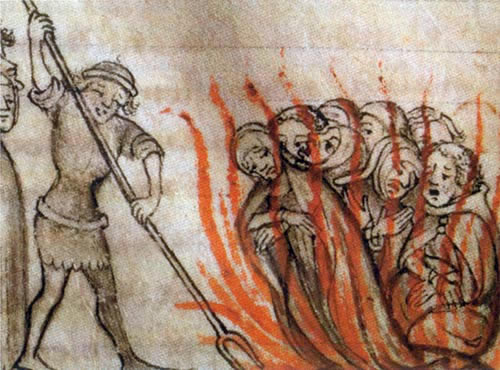by Austin Dacey
Fifty-six years before Salman Rushdie’s The Satanic Verses thrust blasphemy into the spotlight of Western public discourse, the literary debut of a young medical doctor named Rashid Jahan was generating more excitement than she could have imagined. Like Rushdie, Urdu’s literature’s first “angry young woman” drew on Indian Muslim experience. Jahan, however, was never to achieve international celebrity or knighthood, though she did go on to become one of the founders of the radical Progressive Writers Movement and an inspiration to a generation of feminist writers including Ismat Chughtai.
Two early writings—a brief one-act play, “Parde ke Peeche,” translated as “Behind the Veil” or “Behind the Curtain,” and the short story “Sightseeing Trip to Delhi”—starkly depicted the cruelties and injustices of the practice of purdah, the religiously-sanctioned confinement and segregation of women. Both pieces were published in a 1932 anthology called Angarey (Embers). Only five copies survived.
Sunni religious leaders and local newspapers denounced Angarey as an “Absolutely Filthy and Foul” pamphlet of blasphemies. Rashid Jahan and her three fellow contributors faced calls for their deaths by stoning and hanging. She was branded Angareywali—The Angarey Woman—and threatened with disfigurement by acid and knife blade. In March 1933 the authorities of Uttar Pradesh state government intervened, confiscating and destroying the book for the criminal offence of “outraging the religious feelings” of others.
Current headlines notwithstanding, blasphemy did not arrive on the scene just recently with The Satanic Verses, the Danish cartoons of the Prophet Muhammad, or even in the 1966 international human rights treaty that banned “advocacy of religious hatred.” But neither is it the return of a reanimated medieval monster. Rather the present discourse of blasphemy is continuous with a distinctively modern, post-seventeenth century phenomenon in which the spiritual offence of affronting the sacred transformed into the quasi-secular crime of affronting the feelings of believers.
Borrowing from the work of the British historian David Nash, we can distinguish three models for dealing with sacrilegious expression in Western legal tradition, which may be labeled the spiritual, the communal, and the personal.
Spiritual blasphemy is the kind of direct verbal disrespect of the divine presented in Leviticus 24 wherein a “stranger” is executed for abusing the name of Yahweh. Its punishment is motivated by the intrinsic value of something sacred. Blasphemy ordinances emerged in thirteenth century Europe at a time when Church authorities were particularly concerned to maintain doctrinal cohesion in the face of proliferating Christian heresies and secular authorities were concerned to impose new and more pervasive modes of civility and discipline in public life.
Communal blasphemy is a threat to the social order itself. Here the failure to respect sacred authority is theorized, as Nash puts it, “as an attack upon all secular authority that also derived legitimacy from a supreme creator.” In English Common Law, this tradition finds its clearest expression in the 1676 case of John Taylor, who was prosecuted for blasphemy for calling Jesus Christ a “whoremaster” and religion a “cheat.” The Lord Chief Justice, Sir Matthew Hale, held that Taylor’s words were not only “an offence to God and religion, but a crime against the laws, State and government, and therefore punishable in this Court.” Christianity is “parcel of the laws of England, and therefore to reproach the Christian religion is to speak in subversion of the law” and to “dissolve all those obligations whereby the civil societies are preserved.”
The model of personal blasphemy retains the idea that secular authorities have a legitimate interest in suppressing sacrilegious expression but refines the category of the victim. In keeping with the early modern liberal theory of government as an instrument designed to protect the pre-political rights of individual persons, it constructs the victim not as “the State” or “the law” but as the religious sensibilities of citizens, affronts to which constitute threats to public order.
By the mid-nineteenth century, for example, the jury in the case of R. v. Hetherington were told that if its “tone and spirit is that of offence, and insult, and ridicule,” an expression could be classified as blasphemous. The late-nineteenth century opinion in the case of the British magazine The Freethinker characterized the act as “calculated and intended to insult the feelings and the deepest religious convictions of the great majority of the persons amongst whom we live.” Here blasphemy is a failure of due respect but the proper object of that respect has shifted from the godhead to “the common good” to the dignity and rights of persons.
By 1860, the latter, personal model had already been written into the Indian Penal Code under British rule. It was under these laws that Rashid Jahan and Angarey were charged, not with impiety or apostasy, but with outraging religious feelings. In my next column, I turn to the surprising confluence of the European-born tradition of personal blasphemy and non-European religious cultures around the world.
Austin Dacey is a representative to the United Nations for the International Humanist and Ethical Union. He is the author of The Future of Blasphemy: Speaking of the Sacred in an Age of Human Rights and The Secular Conscience: Why Belief Belongs in Public Life. His writings have appeared in the New York Times, USA Today, and Dissent. In 2010, he created The Impossible Music Sessions, a forum in New York City for artists who cannot perform publicly due to censorship, political intimidation or cultural pressure.
With support from the Henry R. Luce Initiative on Religion and International Affairs.

